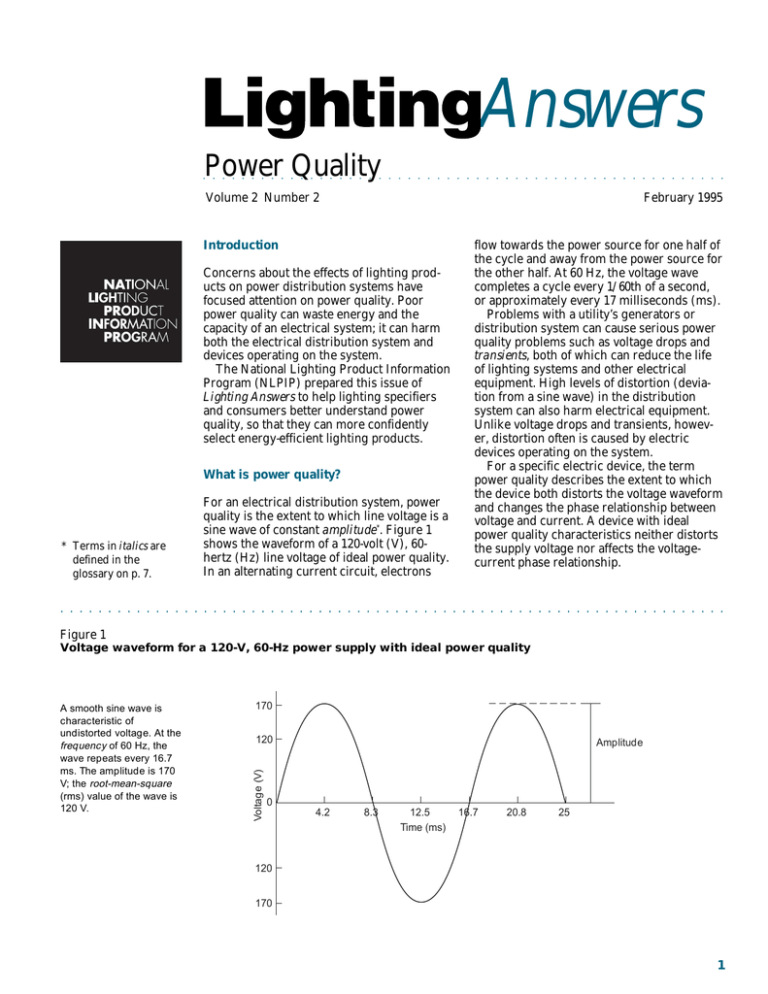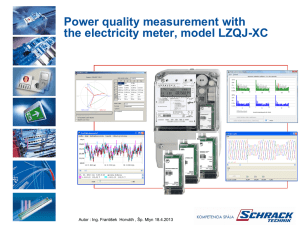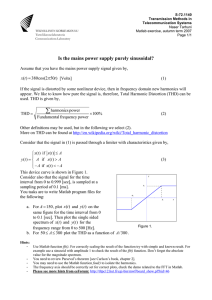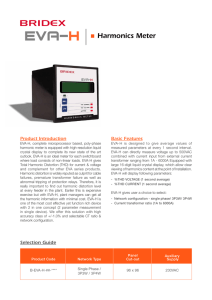
Answers
Power Quality
. . . . . . . . . . . . . . . . . . . . . . . . . . . . . . . . . . . . . . . . . . . . . . . . . . . . . .
Volume 2 Number 2
February 1995
Introduction
Concerns about the effects of lighting products on power distribution systems have
focused attention on power quality. Poor
power quality can waste energy and the
capacity of an electrical system; it can harm
both the electrical distribution system and
devices operating on the system.
The National Lighting Product Information
Program (NLPIP) prepared this issue of
Lighting Answers to help lighting specifiers
and consumers better understand power
quality, so that they can more confidently
select energy-efficient lighting products.
What is power quality?
* Terms in italics are
defined in the
glossary on p. 7.
For an electrical distribution system, power
quality is the extent to which line voltage is a
sine wave of constant amplitude*. Figure 1
shows the waveform of a 120-volt (V), 60hertz (Hz) line voltage of ideal power quality.
In an alternating current circuit, electrons
flow towards the power source for one half of
the cycle and away from the power source for
the other half. At 60 Hz, the voltage wave
completes a cycle every 1/60th of a second,
or approximately every 17 milliseconds (ms).
Problems with a utility’s generators or
distribution system can cause serious power
quality problems such as voltage drops and
transients, both of which can reduce the life
of lighting systems and other electrical
equipment. High levels of distortion (deviation from a sine wave) in the distribution
system can also harm electrical equipment.
Unlike voltage drops and transients, however, distortion often is caused by electric
devices operating on the system.
For a specific electric device, the term
power quality describes the extent to which
the device both distorts the voltage waveform
and changes the phase relationship between
voltage and current. A device with ideal
power quality characteristics neither distorts
the supply voltage nor affects the voltagecurrent phase relationship.
. . . . . . . . . . . . . . . . . . . . . . . . . . . . . . . . . . . . . . . . . . . . . . . . . . . . . . . . . . . . . . . . . . . . . .
Figure 1
Voltage waveform for a 120-V, 60-Hz power supply with ideal power quality
170
120
Voltage (V)
A smooth sine wave is
characteristic of
undistorted voltage. At the
frequency of 60 Hz, the
wave repeats every 16.7
ms. The amplitude is 170
V; the root-mean-square
(rms) value of the wave is
120 V.
Amplitude
0
4.2
8.3
12.5
Time (ms)
16.7
20.8
25
120
170
1
How do lighting systems affect power
quality?
Figure 2
A highly distorted current waveform
465
Current (milliamperes)
Most incandescent lighting systems do not
reduce the power quality of a distribution
system because they have sinusoidal current
waveforms that are in phase with the voltage
waveform (the current and voltage both
increase and decrease at the same time).
Fluorescent, high-intensity discharge
(HID), and low-voltage incandescent lighting
systems, which use ballasts or transformers,
may have distorted current waveforms. Figure 2 shows an example of a highly distorted
current waveform typical of some electronic
ballasts for compact fluorescent lamps. Devices with such distorted current waveforms
draw current in short bursts (instead of drawing it smoothly), which creates distortion in
the voltage. These devices’ current waveforms
also may be out of phase with the voltage
waveform. Such a phase displacement can
reduce the efficiency of the alternating current circuit. In Figure 3, the current wave
lags behind the voltage wave. During part of
the cycle the current is positive while the
voltage is negative (or vice versa), as shown
in the shaded areas; the current and voltage
work against each other, creating reactive
power. The device produces work only during
the time represented by the non-shaded parts
of the cycle, which represent the circuit’s
active power.
Reactive power does not distort the voltage. However, it is an important power quality concern because utilities’ distribution
systems must have the capacity to carry
reactive power even though it accomplishes
no useful work.
4.2
8.3
Time (ms)
12.5
16.7
20.8
–465
. . . . . . . . . . . . . . . . . . . . . . . . . . .
Both lighting manufacturers and building
owners can take steps to improve power
quality. Most electronic ballasts for full-size
fluorescent lamps have filters to reduce
current distortion. Some electronic ballasts
for compact fluorescent lamps have high
current distortion, but contribute very little to
voltage distortion because of their low power.
Magnetic ballasts for fluorescent and HID
lamps typically have lagging current. Some
magnetic ballasts contain capacitors that
resynchronize the current and voltage, which
eliminates reactive power. Building owners
also can install capacitors in their building
distribution systems to compensate for large
loads with lagging current.
. . . . . . . . . . . . . . . . . . . . . . . . . . . . . . . . . . . . . . . . . . . . . . . . . . . . . . .
Figure 3
Phase displacement and reactive power
Phase displacement = 2.1 ms or 45˚
When a device’s current
waveform is out of phase
with the voltage waveform, the difference
between the two is the
phase displacement.
The shaded areas
represent the reactive
power that results.
Voltage (V)
170
-170
2
4.2
8.3
12.5
16.7
20.8
Time (ms)
25
= voltage
= current
= reactive power
generated in
this area
Figure 4
Illustrating harmonics
a.
3 ft
2 ft
b.
1 ft
The distorted waveform in Figure 4a can be described by the sum of one sine wave with frequency
1 Hz and amplitude 2 feet (ft), which is the fundamental, and a second sine wave with frequency 3 Hz
and amplitude 1 ft, which is the third-order harmonic.
The two component waves are shown in Figure 4b.
The “peaks” and “troughs” of the distorted wave result when a peak or trough of the fundamental coincides with a peak or trough of the harmonic. The flat
portions of the distorted wave result when the fundamental and harmonic cancel each other out.
The distorted wave in Figure 4a is similar to what a
rope would look like if one person shook one end at
the frequency and amplitude of the fundamental wave
shown in Figure 4b, while another person shook the
other end at the frequency and amplitude of the thirdorder harmonic shown in Figure 4b.
. . . . . . . . . . . . . . . . . . . . . . . . . . . . . . . . . . . . . . . . . . . . . . . . . . . . . . . . . . . . . . . . . . . . . .
What are harmonics?
A harmonic is a wave with a frequency that is
an integer multiple of the fundamental, or
main wave. Any distorted waveform can be
described by the fundamental wave plus one
or more harmonics, as shown in Figure 4. A
distorted 60-Hz current wave, for example,
may contain harmonics at 120 Hz, 180 Hz,
and other multiples of 60 Hz. The harmonic
whose frequency is twice that of the fundamental is called the second-order harmonic;
the third-order harmonic has a frequency
three times that of the fundamental, and so
forth.
Highly distorted current waveforms contain numerous harmonics. The even harmonic components (second-order, fourth-order,
etc.) tend to cancel out each other’s effects,
but the odd harmonics tend to add in a way
that rapidly increases distortion because the
peaks and troughs of their waveforms often
coincide. The lighting industry calls its most
common measure of distortion total harmonic distortion (THD). The sidebar “Defining
total harmonic distortion and harmonic factor” on p. 4 gives formulas for calculating
THD.
Utilities typically supply voltage with less
than 2% THD. However, current THD for
electronic devices may be very high, often
over 100%. Table 1 on p. 5 lists current THD
from several types of lighting loads, as well
as from common office equipment, as measured by NLPIP. Devices with high current
THD contribute to voltage THD in proportion to their percentage of a building’s total
load. Thus, higher-wattage devices can
increase voltage THD more than lowerwattage devices. If harmonic distortion is a
concern for a lighting system, NLPIP recommends that specifiers use electronic ballasts
with filters to minimize THD.
The recommended maximum allowable
voltage THD at the point where a building
connects to the utility distribution system is
5% (IEEE 1992). Figure 5 on p. 4 shows that
voltage THD reaches this limit when approximately half the building’s load has current
THD of 55%, or when approximately onequarter of the building’s load has current
THD of 115%.
3
Figure 5
Voltage THD resulting from 55% and 115% current THD
(Adapted from Verderber et al. 1993, © 1993 IEEE)
10
Voltage distortion at
service entrance (%)
115% current THD
IEEE 519 limit
5
55% current THD
10
20
30
Percent of total load
40
50
The IEEE voltage THD limit is theoretically exceeded when approximately 47% of the total load in a
building has 55% current THD or when approximately 26% of the load has 115% current THD.
. . . . . . . . . . . . . . . . . . . . . . . . . . . . . . . . . . . . . . . . . . . . . . . . . . . . . . .
What is power factor?
Power factor is a measure of how effectively a
device converts input current and voltage
into useful electric power. It describes the
combined effects of current THD and reactive power from phase displacement. A device with a power factor of unity (1.0) has 0%
current THD and a current draw that is synchronized with the voltage. Resistive loads
such as incandescent lamps have power
factors of unity. A device is said to have high
power factor (HPF) if the power factor is 0.9
or greater. Power factor between 0.5 and 0.9
is called normal power factor (NPF). Magnetic and electronic ballasts for fluorescent
lamps may be either HPF or NPF. HPF ballasts usually have filters to reduce harmonics
and capacitors to reduce phase displacement.
On average these additional components add
about 16% to the retail costs of ballasts (Dorr
et al. 1994).
NLPIP measured power factor for several
types of lighting loads, and for common office
equipment; these data are shown in Table 1.
Defining total harmonic distortion (THD) and harmonic factor
Ballast manufacturers, electric utilities, and standards organizations define THD differently, which has caused some confusion in
the lighting industry. In this report, NLPIP uses the Institute of
Electrical and Electronics Engineers (IEEE) definition for THD
given in IEEE 1035-1989, because that is how ballast manufacturers typically report THD.
THD =
√I2 2 + I3 2 + I42 + …
√I12
× 100 (to convert to percentage),
where I 1 is the root-mean-square (rms) of the fundamental current
waveform
I2 is the rms of the second-order harmonic current waveform
I3 is the rms of the third-order harmonic current waveform, etc.
The American National Standards Institute (ANSI), the Canadian
Standards Association (CSA), and the International Electrotechnical Commission (IEC) use the above formula as the definition of
“harmonic factor.” CSA and IEC define THD as
THD =
√I2 2 + I32 + I42 + …
√I12 + I22 + I32 + I4 2 + …
4
× 100 (to convert to percentage),
where I 1 is the rms of the fundamental current waveform,
I2 is the rms of the second-order harmonic current waveform
I3 is the rms of the third-order harmonic current waveform, etc.
According to the second definition, THD is always less than
100%. The table below gives some conversions between the two
definitions.
Equivalent values of THD using the two definitions
THD (%) as commonly
reported by manufacturers
(IEEE 1035-1989)
THD (%) as defined by
CSA and IEC
5
5
20
19.6
32
30.5
50
44.7
100
70.7
150
83.2
Table 1
Sample power quality characteristics for different electric loads*
Active Power
(W)
Power
Factor
Current THD
(%)
Compact fluorescent lighting systems
13-W quad-tube compact fluorescent lamp w/ NPF magnetic ballast
16
0.54
13
13-W quad-tube compact fluorescent lamp w/ NPF electronic ballast
13
0.50
153
16-W quad-tube compact fluorescent lamp w/ HPF electronic ballast
16
0.91
20
T12 40-W lamps w/ energy-efficient magnetic ballast for T12 lamps
T12 34-W lamps w/ energy-efficient magnetic ballasts for T12 lamps
87
72
0.98
0.94
17
22
T10 40-W lamps w/ energy-efficient magnetic ballast for T12 lamps
93
0.98
22
T12 40-W lamps w/ electronic ballast for T12 lamps
T12 34-W lamps w/ electronic ballast for T12 lamps
72
62
0.99
0.99
5
5
T10 40-W lamps w/ electronic ballast for T12 lamps
T9 34-W lamps w/ electronic ballast for T12 lamps
75
79
0.99
0.99
5
5
T9 32-W lamps w/ electronic ballast for T8 lamps
61
0.98
6
T8 32-W lamps w/ electronic ballast for T8 lamps
63
0.98
6
High-intensity discharge lighting systems
400-W high-pressure sodium lamp w/ magnetic transformer
400-W metal halide lamp w/ magnetic transformer
425
450
0.99
0.94
14
19
Incandescent lighting systems
100-W incandescent A lamp
50-W MR16 low-voltage halogen lamp w/ magnetic transformer
101
62
1.0
0.97
1
6
50-W MR16 low-voltage halogen lamp w/ electronic transformer
51
0.99
10
Office equipment
Desktop computer without monitor
33
0.56
139
13" high-resolution color monitor for desktop computer
Laser printer while in standby
49
29
0.56
0.40
138
224
Laser printer while printing
External fax/modem
799
5
0.98
0.73
15
47
Electric pencil sharpener
85
0.41
33
Full-size fluorescent lighting systems (two lamps per ballast)
* NLPIP measured specific products and reported their characteristics. These characteristics may vary substantially for similar
products; specifiers should check with product manufacturers for specific information.
5
What problems result from poor power
quality?
What limits for current THD and power
factor are used in the lighting industry?
Poor power quality can damage the distribution system and devices operating on the
system. In rare instances, poor power quality
can cause a dangerous overload of the neutral conductor in a three-phase circuit. In this
type of circuit, three power supply wires
share one grounded circuit conductor (the
neutral conductor). In a system with no THD,
the neutral wire carries no current. Highcurrent-THD devices can send odd triple
harmonics (third-order, ninth-order,
fifteenth-order, etc.) onto the voltage supply,
which do not cancel each other out. They add
up on the neutral wire, and if the current
exceeds the wire’s rating, the neutral conductor can overheat and pose a fire hazard.
Voltage distortion can also shorten the life
of utilities’ transformers and cause capacitor
banks to fail. Many utilities impose penalty
charges on their customers if power factor,
measured at the point where the utility service couples to the customer’s site, falls
below a certain value.
Reactive power uses capacity on the distribution system, which limits the amount of
active power that a utility can deliver. This
may be a problem during periods of peak
demand.
When voltage THD is below the IEEE limit
of 5%, most devices do not experience problems. Resistive loads such as incandescent
lamps actually reduce voltage harmonics.
Motor loads also reduce harmonics, but the
motors are subject to overheating as voltage
distortion increases. Fifth-order harmonics
produce particularly negative effects: they
rapidly degrade the motor’s efficiency by
producing torque in opposition to normal for
part of the cycle.
Electric devices such as computers and
fluorescent lighting systems are not affected
by voltage distortion at this level because
their power is filtered through the transformer or ballast.
High-frequency electronic ballasts operate
at frequencies ranging from 20 to 60 kilohertz (kHz). The harmonics produced by
these ballasts are at correspondingly high
frequencies and can interfere with some
communication equipment including radios,
intercoms, and cordless phones. Devices that
use power-line carrier signals, such as synchronized clocks and control modules for
building energy management systems may
also experience problems if harmonics exist
at frequencies close to the carrier signal.
Lighting Answers: Electromagnetic Interference Involving Fluorescent Lighting Systems
(1995) contains more information about this
topic.
Standards organizations have not set power
factor limits for lighting products, except for
the requirement that power factor must meet
or exceed 0.90 for manufacturers to claim
that a product has high power factor. Lighting designers, architects, and other lighting
specifiers often specify HPF ballasts for
buildings with sensitive equipment, such as
hospitals.
ANSI recently established a maximum
current THD limit of 32% for electronic ballasts for full-size fluorescent lamps (ANSI
1993). The new standard also specifically
limits the amplitude of the third-order harmonic to 30% of the fundamental amplitude,
and limits the amplitude of all high-order
harmonics (greater than eleventh-order) to
7% of the fundamental. CSA, IEC, and IEEE
set a 20% current THD limit for electronic
ballasts. Almost all electronic ballasts currently available for 4-foot T12 and T8 lamps
are high power factor with current THD less
than 20%.
Some compact fluorescent lamps (CFLs)
have current THD greater than 100%, but
they have low active power compared with
other high-THD products such as personal
computers, so standards organizations have
not set power quality requirements for CFLs.
Some utilities set current THD requirements for products in their lighting incentive
programs. For example, the Duke Power Co.
in North Carolina and New England Electric
Systems limit current THD for electronic
ballasts for full-size fluorescent lamps to 20%.
Additionally, New England Electric Systems
limits current THD for CFLs to 25%.
6
. . . . . . . . . . . . . . . . . . . . . . . . . . . . . . . . . . . . . . . . . .
Assessing the impact of electric devices on power quality
Electronic devices affect power quality in proportion to their percentage of the total
electric load. For example, an electronic ballast with 32% current THD may produce
less voltage distortion than a magnetic ballast with 20% current THD, because the
electronic ballast uses less power. Similarly, although a 16-W CFL with a low-powerfactor ballast may produce nearly 30 W of reactive power, the amount of power that
a distribution system must carry actually decreases if the CFL replaces a 60-W
incandescent lamp.
Specifiers can use the equations in this publication to estimate the distortion current
produced by electronic devices. For example, consider two devices from Table 1 on
p. 5: the 13-W quad-tube CFL with NPF electronic ballast and the laser printer while
printing. Both devices have rms voltage of 120 V; their rms current can be determined using the power factor equation given in the glossary on p. 7. This gives an
rms current of 0.22 amperes (A) for the CFL and 6.79 A for the printer. These values
are the rms of each device’s fundamental current waveform and can be used in the
THD equation in the sidebar on p. 4 to estimate the total harmonic current of each
device. The resultant values of 0.33 A for the CFL and 1.02 A for the printer show that
although the printer has relatively low current THD (15%), the actual distortion current produced by the printer is more than three times that of the CFL because the
printer uses more power.
Glossary
Resources
active power Also called input power, it is
American National Standards Institute. 1993.
American National Standard for Lamp Ballasts:
High Frequency Fluorescent Lamp Ballasts, ANSI
C82.11 1993. New York, NY: American National
Standards Institute.
the power (in watts) used by a device to produce
useful work.
amplitude The maximum absolute value
attained by a periodic wave.
frequency The number of cycles completed
by a periodic wave in a given unit of time. Frequency commonly is reported in hertz (Hz),
which is cycles per second.
fundamental The component of a periodic
wave that has the lowest frequency. It is also
called the first-order harmonic.
harmonic For a distorted waveform, a component of the wave with a frequency that is an integer multiple of the fundamental.
Benya, James R. 1993. Quick! Read About Power
Quality Now, Before You Fry a Subtransformer.
Architectural Record (Lighting Supplement)
181(8):16–17.
Berutti, Al, and R. M. Waggoner, eds. 1992. Practical Guide to Quality Power for Sensitive Electronic Equipment. Overland Park, KS: Intertec Electrical Group.
Canadian Standards Association. 1992. Measurement of Harmonic Currents, CAN/CSA-C22.2 No.
0.16-M92. Toronto, Ontario: Canadian Standards
Association.
phase displacement The extent to which
voltage and current waveforms are out of synchronous phase with one another. Current “lags” or
“leads” voltage, depending on whether the current waveform crosses a reference point after or
before the voltage waveform, respectively. Phase
displacement can be expressed as a unit of time,
as a fraction of the period, or as an angle in degrees with one period corresponding to 360°.
When voltage and current are synchronized,
phase displacement is zero.
Dorr, Doug, Tom Key, and Gene Sitzlar. 1994.
User Expectations and Manufacturer Tendencies
for System-Compatible Design of End-Use Appliances. Preprint of a paper to be presented at PQA '94
Conference, Amsterdam, 1994.
Institute of Electrical and Electronics Engineers.
1989. IEEE Recommended Practice: Test Procedure
for Utility-Interconnected Static Power Converters,
IEEE 1035-1989. Piscataway, NJ: Institute of
Electrical and Electronics Engineers.
power factor A measure of how effectively
an electric load converts power into useful work.
Power factor (PF) is calculated using the equation:
active power
PF =
rms voltage × rms current
Phase displacement and current distortion both
reduce power factor.
reactive power Power that creates no
useful work; it results when current is not in
phase with voltage. Calculated using the equation:
reactive power = V × A × sinθ
where θ is the phase displacement angle.
root-mean-square (rms) The effective
average value of a periodic quantity such as an
alternating current or voltage wave, calculated by
averaging the squared values of the amplitude
over one period, and taking the square root of that
average.
total harmonic distortion (THD) For
current or voltage, the ratio of a wave’s harmonic
content to its fundamental component, expressed
as a percentage. Also called “harmonic factor,” it
is a measure of the extent to which a waveform is
distorted by harmonic content.
transients For an alternating current circuit,
———. 1992. IEEE Guide for Harmonic Control
and Reactive Compensation of Static Power Converters, IEEE 519-1992. Piscataway, NJ: Institute
of Electrical and Electronics Engineers.
———. Standards Coordinating Committee. 1992.
IEEE Standard Dictionary of Electrical and Electronics Terms, IEEE 100-1992. Piscataway, NJ:
Institute of Electrical and Electronics Engineers.
———. Working Group on Power System Harmonics. Load Characteristics Task Force and
Effects of Harmonics Task Force. 1985. The
Effects of Power System Harmonics on Power
System Equipment and Loads. IEEE Transactions
on Power Apparatus and Systems 104(9):2555–
2563.
International Electrotechnical Commission. 1982.
Disturbances in Supply Systems Caused by Household Appliances and Similar Electrical Equipment,
Part 1: Definitions, IEC 555-1-1982. Geneva,
Switzerland: International Electrotechnical Commission.
Verderber, Rudolph R., Oliver C. Morse, and
William R. Alling. 1993. Harmonics From Compact Fluorescent Lamps. IEEE Transactions on
Industry Applications 29(3):670–674.
a momentary voltage surge, often at amplitudes
10 to 20 times the normal voltage.
7
NLPIP Publications
Guide to Performance Evaluation of Efficient Lighting
Products, 1991
Specifier Reports:
Power Reducers, 1992
Specular Reflectors, 1992
Occupancy Sensors, 1992
Parking Lot Luminaires, 1993
Screwbase Compact Fluorescent
Lamp Products, 1993
Cathode-Disconnect Ballasts, 1993
Exit Signs, 1994
Electronic Ballasts, 1994
Reflector Lamps, 1994
Specifier Reports Supplements:
Screwbase Compact Fluorescent
Lamp Products, 1994
Exit Signs, 1995
Lighting Answers:
T8 Fluorescent Lamps, 1993
Multilayer Polarizer Panels, 1993
Task Lighting for Offices, 1994
Dimming Systems for High-Intensity
Discharge Lamps, 1994
Electromagnetic Interference Involving
Fluorescent Lighting Systems, 1995
Thermal Effects in 2´x4´ Fluorescent
Lighting Systems, 1995
Power Quality
Volume 2, Number 2
February 1995
Author: Robert Wolsey
Program Director: Robert Davis
Editors: Amy Fowler and Kevin Heslin
Production: Jason Teague and Nancy Bayer
Graphics: Jason Teague
Reviewers: Warren Anderson (OSRAM SYLVANIA INC.), Dennis Gibbs
(PSI Energy), Brien Krieger (PSI Energy), Dave Pileggi (New England
Power Service Company), Chris Prince (PSI Energy), Mark Rea (Lighting
Research Center), Dave Torrey (Rensselaer Polytechnic Institute), and
Dave Toso (Madison Gas and Electric Company). Reviewers are listed to
acknowledge their contributions to the final publication. Their approval or
endorsement of this report is not necessarily implied.
Other Lighting Research Center members who contributed include
Andrew Bierman, Arnold Buddenburg, Kathryn Conway, Ed Gandorf,
Yunfen Ji, and Russell Leslie.
Copyright © 1995 Rensselaer Polytechnic Institute. All rights reserved. No
portion of this publication or the information contained herein may be
duplicated or excerpted in any way in any other publications, databases, or
any other medium without express written permission of the publisher.
Making copies of all or part of this publication for any purpose other than
for undistributed personal use is a violation of United States copyright laws.
It is against the law to inaccurately present information extracted from Lighting
Answers for product publicity purposes. Information in these reports may not
be reproduced without permission of Rensselaer Polytechnic Institute.
Program Sponsors
Hydro-Québec
Iowa Energy Center
Lighting Research Center
New England Electric Companies
New England Power Service Company, New
England Power Company, Massachusetts Electric
Company, The Narragansett Electric Company,
Granite State Electric Company
New York State Energy Research and
Development Authority
Northern States Power Company
Southern California Edison Company
PSI Energy
United States Department of Energy
United States Environmental Protection Agency
Wisconsin Center for Demand-Side Research
The products described herein have not been tested for safety. The
Lighting Research Center and Rensselaer Polytechnic Institute make no
representations whatsoever with regard to safety of products, in whatever
form or combination used. The information set forth for your use cannot be
regarded as a representation that the products are or are not safe to use in
any specific situation, or that the particular product you purchase will
conform to the information found in this report.
ISSN 1069-0050
. . . . . . . . . . . . . . . . . . . . . . . . . . . . . . . . . . . .
For publications ordering information, contact:
Lighting Research Center
Rensselaer Polytechnic Institute
Troy, NY 12180-3590
Telephone: (518) 276-8716
Fax: (518) 276 -2999
Internet e-mail: lrc@rpi.edu
Lighting Answers is printed on a paper that is made from
50% recycled fiber, including 10% post-consumer waste.
Lighting Answers complements the National Lighting Product
Information Program’s (NLPIP) other serial, Specifier Reports.
Each issue of Lighting Answers presents educational information about a specific topic or a particular technology. For some
issues, NLPIP may perform limited testing. For this issue of
Lighting Answers, NLPIP has summarized available information
about power quality and performed limited testing.
8






